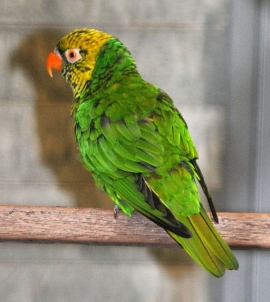Yellow and Green Lorikeet |
|
|
Also known as: Yellow-green Lorikeet, Sula Lorikeet, Citrine Lorikeet
Photos
View in GalleryDid You Know?
The tongue of the Yellow and Green Lorikeet is specially adapted for harvesting pollen and nectar from flowers. It is tipped with elongated papillae (finger-like projections) to enable the bird to easily reach these food sources.Academic Research
Related publications: Trichoglossus flavoviridisSpecies Profile
Genus: Trichoglossus | Species: flavoviridis
Size:
20cm (7.8 in)
Weight:
80-95g (2.8-3.3 oz)
Subspecies including nominate:
one
Colour Adult:
Both adults in general green; olive/yellow forehead and crown; nuchal collar brown; yellow throat and breast to abdomen, with dark green scalloping; yellow/green flanks to undertail coverts; yellow/green underwing coverts. Bill orange/yellow. Lores and eye-ring bare and pink/orange. Eye orange/yellow.
Colour Juvenile:
More green where yellow markings are. Bill brown. Lores and eye-ring bare and white. Eye brown.
Call:
Calls made in flight are high-pitched and screechy. While feeding in flocks birds give series of moderately pitched, slurred squeaky chattering notes with upward inflection. Also emits high-pitched whistles.
Video Links:
Video 1More Information:
Content Sources:
CITES
The Lory Link
BirdLife International
Cornell Lab of Ornithology/Birds of the World
Parrots: A Guide to Parrots of the World, Juniper and Parr, 1998
ML Media Collection Catalogue 32793, Yellow and Green Lorikeet Trichoglossus flavoviridus, van den Berg, Arnoud, Sulawesi Tengah, Indonesia, Jul. 23 1984, Cornell Lab of Ornithology. Site
Parrots of the World, Forshaw, 2006. 2010 edition
Parrots in Aviculture, Low, 1992.
Lexicon of Parrots, Thomas Arndt.
Parrots: Their Care and Breeding, Low, 1986.
Photos
View in GalleryDid You Know?
The tongue of the Yellow and Green Lorikeet is specially adapted for harvesting pollen and nectar from flowers. It is tipped with elongated papillae (finger-like projections) to enable the bird to easily reach these food sources.Academic Research
Related publications: Trichoglossus flavoviridisSpecies Care
Captive Status:
Fairly common.
Longevity:
Probably 25-35 yrs
Housing:
Enclosure with well drained, concrete or tiled floor, or indoor aviary, minimum length 1.8m (6 ft) within a tiled room for ease of cleaning.
Diet:
Nectar such as a commercial type or homemade from: lactose-free baby cereal, honey and malt extract or molasses, mixed with filtered water and made fresh once or twice daily, and comprising at least 40 percent of the diet; fruits such as: apple, pear, orange, bananas, cactus fruits, pomegranate; vegetables such as: carrot, celery, corn on the cob or frozen sweet corn; green leaves such as: Swiss chard, lettuce, dandelion, sowthistle, chickweed; dried figs soaked in water for a few hours; spray millet; small amount of soaked or sprouted sunflower seed and small amount of canary seed and/or oats.
Enrichment:
Provide bird-safe, unsprayed flowering branches, different sized perches, foraging/puzzle toys, easy-to-clean ladders, noise makers and swings. Also provide overhead misters or shallow water bowls for bathing.
Nest Box Size:
Hinged lid nestbox or L-shaped nestbox, at least 10" x 10" x 25" (25.4cm x 25.4cm x 63.5cm).
Clutch Size:
2
Incubation Time:
23 days
Fledging Age:
7-8 weeks
Hatch Weight:
3-4g (0.1-0.14 oz)
Peak Weight:
45-55g (1.6-1.9 oz)
Weaning Weight:
50g (1.75 oz)
Specialist Club:
Photos
View in GalleryDid You Know?
The tongue of the Yellow and Green Lorikeet is specially adapted for harvesting pollen and nectar from flowers. It is tipped with elongated papillae (finger-like projections) to enable the bird to easily reach these food sources.Academic Research
Related publications: Trichoglossus flavoviridisSpecies Wild Status
World Population:
Unknown, stable.
IUCN Red List Status:
Least Concern
CITES Listing:
Appendix II
Threat Summary:
Not globally threatened. A BirdLife “restricted-range” species. Locally common. On Taliabu, species is most common in montane forest, which is still relatively secure and may be made into a preserve.
Range:
Taliabu, Mangole, and Sulabesi, in Sula Islands.
Habitat:
Found up 800-2000m (2624-6560 ft) from lowland to upper montane rainforest; also has been seen in open country where Erythrina sp. is flowering, along forest edge and in isolated stands of trees.
Wild Diet:
Feeds on nectar, flowers, fruits, pollen and seeds.
Ecology and Behaviour:
Seen usually in small groups, noisily mixing with Ornate Lorkeets while foraging. Is shy, keeping to dense foliage where it is nearly impossible to detect.
Clutch and Egg Size:
2 eggs
Breeding Season:
Not recorded.
Photos
View in GalleryDid You Know?
The tongue of the Yellow and Green Lorikeet is specially adapted for harvesting pollen and nectar from flowers. It is tipped with elongated papillae (finger-like projections) to enable the bird to easily reach these food sources.Academic Research
Related publications: Trichoglossus flavoviridisMembers Only Resources
Please log-in now to find more research, resources and tools.
Not a Member?
Find more great information:
Gain exclusive access to 600+ pages of additional research, seminars and podcasts, specialists to ask your toughest questions, and dozens of other fun resources - when you become a WPT member.
Join Today >>

































